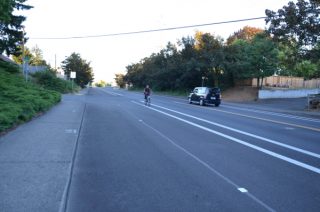
(Photo: M.Andersen/BikePortland)
Here’s an example of the sort of incremental bike-lane improvement we can hopefully expect to see more of now that the city has $9 million more per year to repave roads.
This spring, the city refinished East Burnside Street with a smooth new coat of asphalt. And when they did, they converted the 1990s-style door-zone bike lane to a more comfortable buffered bike lane between Interstate 205 and approximately 90th Avenue.
It’s not a major improvement but it does extend what was already a buffered bike lane on Burnside’s bridge across I-205 by about a third of a mile. This is the most comfortable crossing of I-205 anywhere south of Marine Drive, so it’s nice to improve the comfort a bit further west.
Advertisement
Burnside’s bike lanes remain tantalizingly incomplete — there’s a maddeningly short gap right around 82nd, plus the big one between East 13th Avenue and East 68th — but thanks to the I-205 crossing, the lanes seem to get plenty of use. I had three strangers in my riding cohort at 8:30 p.m. on a Tuesday night, and passed someone coming the other way at 82nd.
Why the city didn’t add some plastic bollards to create a floating parking lane and a protected curbside bike lane on this short stretch? I’m not sure. It’d have required some parking removal near the intersections but the parking lane seems to be barely in use today. Garbage collection, sweeping and plowing might have been part of it.
Incremental changes like these are useful, but without political action they’ll never amount to a complete, comfortable biking network.
In any case, this is a good example of how “maintenance” work in a city with bike-friendly staff can improve biking here and there. And it’s also a good illustration of the fact that without political action, incremental changes like these will never amount to a complete, comfortable biking network. This was a nice way to carve a little bit more bike space out of what had been needlessly wide auto lanes, but the moment an actual tradeoff was required — better bike lanes or auto parking, a choice forced because the street narrows west of 90th — the status quo wins. On that stretch, parking remains, now sitting atop a beautiful new coat of asphalt.
Removing parking here would have had political costs in a city with many battles to fight. But it’s a good indication that Portland will never, ever achieve its transportation goals without some sort of change to the political game.
— Michael Andersen, (503) 333-7824 – michael@bikeportland.org
Our work is supported by subscribers. Please become one today.


